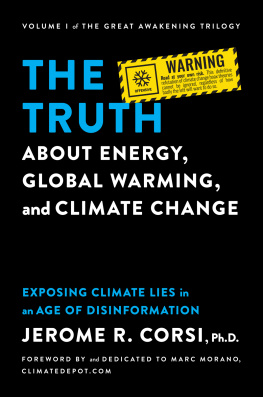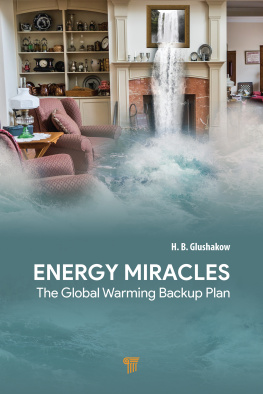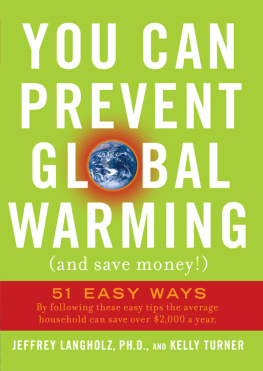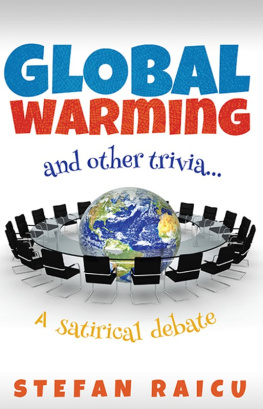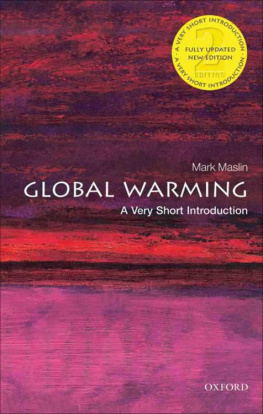
Praise for 50 Simple Steps
The direct impact of our lifestyles on global warming is no longer in question. 50 Simple Steps is your guidebook for becoming part of the solution, starting today. Well-researched and easy to digest, this book empowers positive action and helps you to act on your good intentions.
Greg Horn, Author ofLiving Green: A Practical Guide to Simple Sustainability;Co-founder and CEO of Eco Shoppe; former CEO of GNC and Garden of Life
50 Simple Steps offers practical, step-by-step advice for greening every part of your life, from the car you drive to the food on your plate. We all need to become Green Patriots, and heres how to do it.
Jim Motavalli, Editor ofE/The Environmental Magazine;Co-author ofGreen Living: The E Magazine Handbook for Living Lightly on the Earth
50 Simple Steps lays out a wealth of options and opportunities that anyone can doat home, at work, in the marketplace, and in the voting booth. Its clear, compelling descriptions and take-action resources make this an indispensable resource for anyone concerned about the future of our families, our communities, and the planet.
Joel Makower, Executive Editor, GreenBiz.com and ClimateBiz.com; Co-founder, ClimateCounts.org

Copyright 2008 Freedom Press
All rights reserved. No portion of this book may be reproduced in any manner whatsoever or transmitted electronically without authorized consent of Freedom Press, except in the context of reviews. The authors collected facts from various established organizations and credible websites regarding the quantified effects of the 50 Simple Steps on atmospheric greenhouse gases.
The authors were not able to independently audit these numbers or calculations, but they referenced their sources. The authors dont and cant guarantee the results stated in the title; however, they are optimistic that, cumulatively, the steps presented in this book will have far-reaching positive effects in the battle of humans versus global warming.
Cover and book design by Bonnie Lambert
ISBN: 978-1-893910-49-2
Ebook ISBN: 978-1-893910-39-3
First Printing
Printed in the United States
Published by Freedom Press
1861 North Topanga Canyon Boulevard
Topanga, CA 90290
Bulk Orders Available: (800) 959-9797
E-mail: info@freedompressonline.com

For our great, great, great, great grandchildren and beyond.
Acknowledgements
W e, the members of the Green Patriot Working Group, have noticed our own lives and attitudes have been very positively affected by working on this book, and we hope that you, the reader, will experience the same. Thank you to all of those people without whom this book would not have been possible, especially Jodey Brown, Randi Clausen, Brittany Davis, Cassandra Glickman, Kim Henderson, Bonnie Lambert, Evan Michael Lowenstein, and Carly Zinderman. Thank you also to our editor Sheila Huettl and our assistant editor Tracy Marcynzsyn.
Wed like to thank the green leaders who have supported us including Greg Horn, Devra Lee Davis, Joel Makower, and Jim Motavalli. Thank you to R. James Woolsey for so graciously agreeing to write our Foreword, and to his assistants Nancy Bonomo and Debbie Willie. Thank you especially to David Steinman for providing inspiration an belief in this important project.
And thank you to every individual, organization, company, and governmental agency that is referenced in this book. Because of your efforts to date and those of thousands of companies and organizations that we didnt have room to mention here, we are convinced that humankind has the desire and the dedication to make the critical difference in our fight against global warming.
The Green Patriot Working Group
Los Angeles, 2007
Table of Contents
Why Should I Participate?
50 Simple Steps
Foreword
E arly in the opening section of this book, the authors set out their definition of what they call Green Patriotism: Environmentalism, National Security, and Public HealthThree Victories for the Price of One!
Exactly. And that is both the strength and the charm of this very practical little book. Although full of useful suggestions about how to make changes in our daily lives that can help us do our part to reduce the risk of climate change, there are several other echoes in these 50 steps. You continually have the feeling that the authors are seeking to help you get involved in something of extraordinary importance.
The risk of climate change alone should be enough to motivate us. Even though critics accurately point out that the earth has seen substantial climate change over the eons before the coming of the industrial age, and there may be greater forces at work than human-produced emissions, it is still reasonable for us all to reduce the degree to which we are loading up the atmosphere with, principally, carbon dioxide. It is as if, as a civilization, we are smoking six packs of cigarettes a day. (Actually, there is some similarity between metastasis in the human body and the potential catastrophic climate change that may be caused by such developments as the rapid melting of the tundra and the resulting accelerated release of dangerously global warming methane.) Yes, climate change occurred before human industrial emissions, and some human beings got lung cancer before anyone smoked, but it is only common sense for us to reduce or stop smoking in order to reduce the probability of catastrophic changes in our lungs. So too with the ecosphere.
As the authors point out, public health also gives us in more than a metaphorical senseample reason to make some changes in our daily lives. Buying organic and locally grown foods are two recommended steps that serve both the climate-change and health objectives. And so does moving away from the use of gasoline and toward the use of renewable fuels such as ethanol, methanol, butanol, and biodiesel (or renewable diesel, or even plain vegetable oil) for transportation fuel. For example, President Bushs current Ambassador to the European Union, the distinguished attorney (and White House Counsel to the first President Bush) Boyden Gray, has stressed the carcinogenic nature of the exhaust of vehicles running on gasoline. As Gray wrote in a seminal article last year in the Texas Review of Law and Politics, this is heavily because the so-called aromatics that are used to enhance octane in gasoline are clearly cancer-causing. Renewable fuels such as those suggested here are not.
The authors third objective is to enhance national security by offering steps that will help move us away from paying so much (as of late 2007, we borrow nearly a billion dollars a day just to import oil) to unstable, hostile foreign powers. Several of the recommended steps clearly serve this important objective.
And finally, implicit in the recommendations is a fourth objectiveto take steps to promote local self-sufficiency. Both Jefferson and Ghandi advocated local self-sufficiency as an important determinant of the way we should manage our lives. The spinning wheel in the middle of the Indian flag is there to symbolize that, in addition to independence and non-violence, Gandhi placed heavy reliance on the importance of self-sufficiency. In the India of his time, this meant in part that an Indian village should spin its own cotton on spinning wheels rather than ship raw cotton to Britain. Gandhis point was not to promote mindless autarky but rather to teach that enhanced freedom accompanies local self-sufficiency. Jeffersons point was similar in his extended argument with Hamilton about the future of the American economy. Yeoman farmers who were as self-sufficient as possible would, he felt, be better able to resist tyranny. The technology enabling distributed generation of energy and other steps toward local self-sufficiency may finally be catching up with Ghandis and Jeffersons ideas and beginning to make possible a modern prosperous life together with a stronger commitment, where it makes economic sense, to local self-reliance.
Next page



